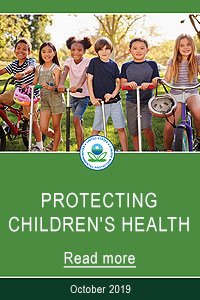Protecting Children's Health October 2019 Booklet
From the executive summary:

Environmental officials increasingly recognize that the differences between children and adults are critical to acknowledge when establishing environmental health protections. Children in all stages of life, from infancy through adolescence, as well as pregnant women, face environmental health hazards in both the natural and built environments. Because children’s neurological, immunological, respiratory, digestive, and other systems are still developing, they are more vulnerable than adults to environmental risk factors. In many cases, their responses are substantially different – qualitatively and quantitatively – from those exhibited by adults. EPA is committed to assuring newborns have the best possible start in life by seeking to decrease exposures during vulnerable life stages and improve children’s environmental health outcomes.
Read the full booklet, below.
